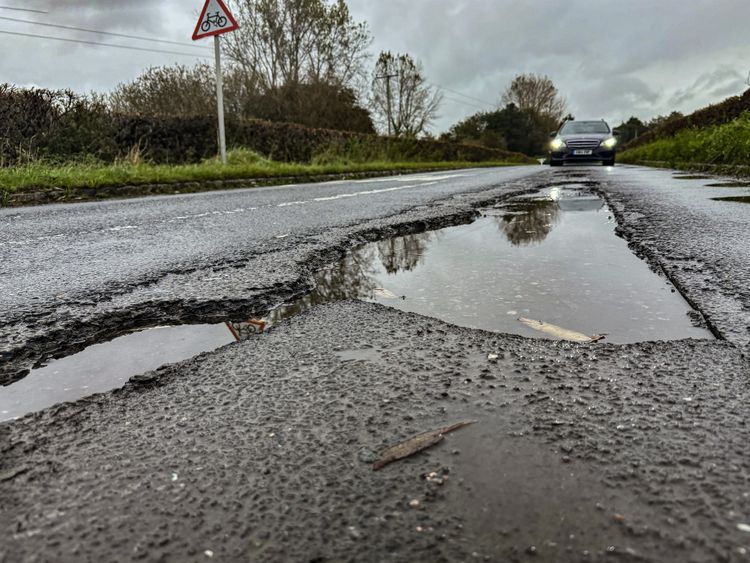Decades of underfunding have created a vast asset inventory that doesn’t meet the performance standards expected of it
Thousands of substandard bridges
The ICE’s 2025 State of the Nation report calls for greater investment in asset management across all parts of the transport network. Transport Scotland’s chief bridge engineer, Dr Hazel McDonald, spoke at the publication’s launch event in January. She noted that almost 3,000 road bridges around the UK were substandard, unable to carry the heaviest vehicles.
Increasing traffic volumes and axle loads, combined with the erosive effects of climate change, will inevitably push more structures into this category if no effective remedial action is taken.
McDonald warned that the risk of bridge failures was growing fast, as signalled by so-called precursor events – the appearance of cracks in key components, for instance. Such incidents, she said, should be disclosed to Collaborative Reporting for Safer Structures (CROSS-UK).

Image credit: Paul Weston
The need for standardisation
McDonald added that a collaborative push was required to unify and standardise condition reporting. Transport authorities around the country use a range of systems to do this. A more coordinated approach would, she said, help engineers to form a shared understanding of the problems and develop a common set of solutions.
Her call for greater uniformity was backed a few months later by Helen Rowe, chair of the ADEPT national bridges group.
Speaking at the ICE’s 2025 Summer Prestige Debate in June, Rowe said: “We need to be able to compare the conditions of structures in different parts of the country and determine where the need is greatest. It’s essential to adopt a risk-based approach to investment nationally so that needs can be prioritised.”
Other panellists at the event highlighted the lack of standards for council-controlled roads and other highway structures – the Design Manual for Roads and Bridges contains the UK’s main set of technical standards and guidance but it’s more geared to trunk routes. They also noted the lack of regulatory oversight for local roads.
Strategic roads and all railways in Great Britain are regulated by the Office of Rail and Road (ORR), which was represented at the debate by its director of planning and performance, Feras Alshaker.
The Summer Prestige Debate panellists (l-r): Feras Alshaker, Dr Janvi Shah, Helen Rowe and Lila Tachtsi, with chair David Porter
He reported growing concerns about the condition of structures across both networks, observing that “the scale of the challenge is creeping up”.
Lila Tachtsi, director of engineering and asset management for Network Rail’s eastern region, added that increasingly harsh weather conditions had made it harder for her organisation to inspect assets and complete repairs in recent years.
We need to be able to compare the conditions of structures in different parts of the country and determine where the need is greatest
Helen Rowe, chair of the ADEPT national bridges group
A dearth of information
Speaking after the debate, Helen Rowe notes that many local authorities lack the resources to accurately record the performance of structures across their networks. The huge gaps in council data suggest that routine inspections are being missed, she says. Such records are still paper-based at many councils.
Rowe, who is also structures and tunnels asset manager at Kent County Council, highlights the RAC Foundation’s annual bridges survey, which polls the 200-plus local highways authorities in Great Britain.
She says: “There was a 2,000-plus difference in the reported number of local authority-owned road bridges between the 2023 and 2024 surveys. This discrepancy indicates that the data being submitted is unreliable.”
Another cause for concern is that many authorities simply haven’t bothered responding to the survey’s more probing questions, Rowe adds. These should be “easy to answer for any authority that’s on top of its statutory responsibilities and using an adequate asset management database”.
Can advanced tech help to solve the problem?
Drone- and vehicle-mounted imaging systems with AI-powered processing offer new ways to monitor highways infrastructure for defects.
While many local authorities have adopted such technology, taking advantage of its efficiency and ability to inspect less accessible assets, many others have baulked at its upfront cost and need for skilled operators.
Helen Rowe says: “We’re aware of the technology – we’d like to have it. But the set-up and maintenance costs can make such solutions unattainable.”
James Bailey reports that Staffordshire County Council uses several digital twins to help it monitor its highways assets, but he acknowledges that “the cost of creating these is quite significant”.
Although investing in such tech is worthwhile “when you’ve got a unique or high-risk situation”, the cost of rolling it out on a larger scale would be harder to afford, Bailey suggests.
Several initiatives to develop digital models and databases have yet to fulfil their potential, often hindered by resourcing constraints. Take the National Underground Asset Register (NUAR), for instance. This is a government scheme led by the Geospatial Commission to create a digital map of subterranean pipes and cables in England, Wales and Northern Ireland.
Council-controlled roads include many geotechnical structures, which have been used extensively by utilities companies. Yet local authorities have so far entered little information about these assets into the NUAR.
“Their data often isn’t in the right formats,” Rowe says. “And they don’t have enough capacity to collate and provide it anyway, even though the benefits of doing so are clear to them all.”
A worrying skills gap
It was noted at the debate that many council highways engineering teams have been pared back to the bone.
The fear is that they are lacking vital technical skills. This was highlighted in a recent CROSS-UK safety report entitled Concern Over the Experience of a Highway Authority Appointee.
The report explained that “a highway authority has decided to appoint someone without a structural or civil engineering degree, equivalent experience or any prior involvement with structures. Their role is to undertake structural principal and general inspections, structural assessment and structural reviews.”
CROSS-UK’s expert panel noted that this was a “very worrying report” of a situation from which “there is unlikely to be a good outcome”.
It added: “The competency of any post-holder is… more critical than ever, not just for buildings post-Grenfell, but for every safety-critical structure that may impact the general public.”
Helen Rowe (centre) is particularly concerned about haphazard maintenance record-keeping among local highways authorities
Despite four decades of warnings about the managed decline of local authority roads, their condition was still passable as recently as 10 years ago, Rowe says. But she adds that their rate of deterioration has since been exponential. The pothole problem serves as a proxy for the less visible poor condition of most highways infrastructure under council control.
Time for a funding shake-up
In UK Infrastructure: A 10-Year Strategy, the government recognises the pressures on road transport, including the physical impacts of climate change and an anticipated 10% increase in vehicle mileage over the next decade. The document states that £24bn has been earmarked to be spent on both motorways and local roads over this Parliament.
Funding is allocated to councils based on the total length of the roads under their control, taking no account of their condition, the amount of traffic they carry or their strategic importance.
Until 2019, the Department for Transport (DfT) required local authorities to report annually on the depreciation in the value of their highways assets. Helen Rowe advocates restoring this “rough and ready measure of need”.
She explains: “Under that reporting system, if a council’s assets had lost £50m or more in value, it was required to explain why. This had the potential to be a highly effective way of focusing attention and setting priorities.”
Predictable long-term funding for council highway maintenance would be more helpful than the current fluctuating annual investment cycle. An investment programme lasting at least 10 years would be appropriate, given the extent of the repair backlog, the complex logistics of working on local roads and the constraints on the supply chain.
In June 2024 the National Audit Office published The Condition and Maintenance of Local Roads in England. This recommended that the DfT should:
- Update its requirements on councils to report road surface conditions.
- Require data from them on the condition of other key highways assets.
- Review its approach to allocating capital funding, including measures to prioritise works and assess effectiveness, focusing on long-term goals.
Sign up to receive news from ICE Knowledge direct to your inbox.










